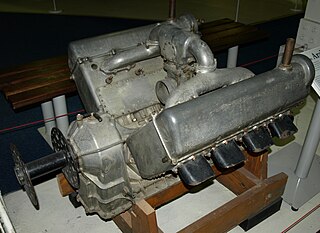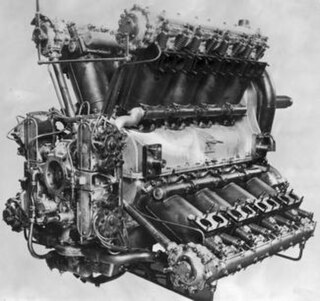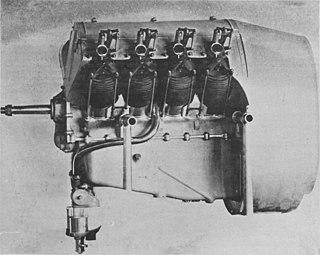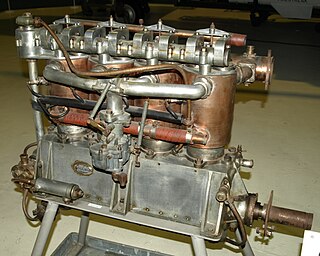
The Sunbeam Arab was a British First World War era aero engine.
The Bristol Hydra was an experimental 16-cylinder, twin-row radial aircraft engine built by the Bristol Engine Company. It is a relatively rare example of a radial with an even number of cylinders per row – it is often claimed that radial engines require an odd number of cylinders, but this is simply easier, not physically required. Only two Hydras were built, the type never entered production.

The Siddeley Tiger was an unsuccessful British aero engine developed shortly after the end of World War I by Siddeley-Deasy. Problems encountered during flight testing caused the project to be cancelled.

The Sunbeam Matabele was a British 12-cylinder aero engine that was first flown in 1918. The Matabele was the last iteration of one of Sunbeam's most successful aero engines, the Cossack.

The Sunbeam Manitou was an aero-engine produced by Sunbeam. Unsuccessful as an aero-engine, it is best known for having powered the Sunbeam 350HP racing car.

The de Havilland Gipsy Minor or Gipsy Junior is a British four-cylinder, air-cooled, inline engine that was used primarily in the de Havilland Moth Minor monoplane, both products being developed in the late 1930s.

The Napier Cub was an unusual and very large experimental 1,000 horsepower (750 kW) 16-cylinder 'X' pattern liquid-cooled aero engine built by the British engine company D. Napier & Son. The Cub was the only Napier 'X' engine design. First flown on 15 December 1922 in an Avro Aldershot biplane bomber aircraft, the only other application was in the Blackburn Cubaroo. Only six engines of this type were ordered and produced.

The Napier Javelin was a British six-cylinder inline air-cooled engine designed by Frank Halford and built by D. Napier & Son. First flown in March 1934 in the prototype of the Percival Mew Gull racing aircraft, the engine was also used in the Spartan Arrow biplane and the Percival Gull.

The Armstrong Siddeley Deerhound was a large aero engine developed by Armstrong Siddeley between 1935 and 1941. An increased capacity variant known as the Boarhound was never flown, and a related, much larger, design known as the Wolfhound existed on paper only. Development of these engines was interrupted in April 1941, when the company's factory was bombed, and on 3 October 1941 the project was cancelled by the Air Ministry.
The Rolls-Royce Eagle XVI was a British experimental 16 cylinder aero engine designed and developed by Rolls-Royce Limited in 1925. The engine was test run but did not fly, the project, together with the planned larger variant, the Eagle XX, was cancelled in favour of the Rolls-Royce Kestrel, that was being developed concurrently.
The Blackburn Cirrus Midget was a British four-cylinder, inverted, inline air-cooled aero engine designed and built in 1937 by the Cirrus Engine Section of Blackburn Aircraft Limited. Little is known of its development and use, its sole aircraft application being reported as the Chilton D.W.1 although it is possible that this did not transpire.

The Renault 70 hp or Type WB was a French V-8 aero engine that first ran circa 1907. It was also manufactured under license by Renault Limited of West Brompton, London between August 1914 and December 1918, three other companies, including Rolls-Royce, also produced the engine. A variant known as the Type WC used an external oil pump as opposed to the internal pump of the Type WB. The Renault V-8 engines were noted as inefficient but reliable, the inefficiency being mainly due to the excessively rich fuel/air mixture used to assist cooling.

The Renault 80 hp, or Type WS in British service, was a V-8 aero engine that first ran in 1914. The engine was manufactured in Britain by Renault Limited of West Brompton, London between August 1914 and December 1918, seven other companies, including Rolls-Royce and Brazil Straker, also produced the engine. The Renault V-8 engines were noted as inefficient but reliable, the inefficiency being mainly due to the excessively rich fuel/air mixture used to assist cooling.

The Green C.4 was a British four-cylinder, water-cooled aero engine that first ran in 1908, it was designed by Gustavus Green and built by the Green Engine Co and Aster Engineering. The engine was one of two Green designs to win a government prize.

The Green E.6 was a British six-cylinder, water-cooled aero engine that first ran in 1911, it was designed by Gustavus Green and built by the Green Engine Co and Mirlees, Bickerton & Day of Stockport between August 1914 and December 1918.

The Green D.4 was a four-cylinder watercooled inline piston engine produced by the Green Engine Co in the UK in 1909. It produced about 60 hp (45 kW) and played an important role in the development of British aviation before World War I.

The Sunbeam Cossack was a British 12-cylinder aero engine that was first run in 1916. The Cossack spawned a family of engines from Sunbeam.
The Sunbeam Afridi was an aero-engine produced by Sunbeam during the First World War.
The Sunbeam Nubian, also called the Sunbeam 155 hp, was a British 8-cylinder aero-engine that was first run in 1916.
The Sunbeam Spartan was a British 12-cylinder aero-engine designed and built in 1916.















